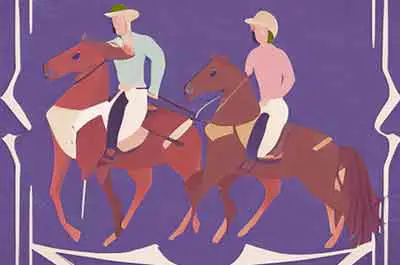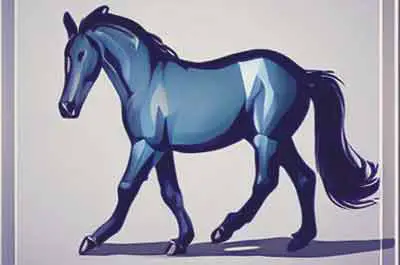If you’ve ever wanted to learn to horseback ride, now is the time to learn! Horseback riding can be a lot of fun and is a great way to get some exercise. In this guide, we’ll teach you the basics of horseback riding. We’ll also cover what you need to know before you start, such as what type of clothing to wear and what kind of equipment you’ll need. Keep reading for everything you need to know about horseback riding!
Make sure you have the proper clothing and footwear.
You’ll want to wear comfortable clothes that you can move around in easily. Jeans or khakis are a good choice. You should also avoid wearing loose clothing that could get caught on the saddle or horse’s tack.

You should also wear closed-toed shoes with low heels, such as riding boots, sneakers, or even cowboy boots (Don’t wear sandals or Crocs!). If you’re riding in hot weather, dress in light, breathable fabrics.
In terms of equipment, you’ll need a helmet and a pair of gloves. Your riding instructor will likely have helmets available for you, but if you have your own, you’re welcome to bring them. As for gloves, they help protect your hands from the reins and keep them warm in cold weather. Again, your instructor may have gloves available, but feel free to bring your own if you prefer.
The most important thing you’ll need is a saddle. You’ll sit in this while riding, which helps keep you balanced on the horse. You’ll also need a bridle, which is a piece of equipment that goes over the horse’s head. It has a bit that goes in the horse’s mouth, and it’s used to help steer and stop the horse. You can usually rent them from a riding stable. If you’re riding regularly, though, you may want to purchase your own equipment.
Familiarize yourself with the horse.
Before you get on a horse, you should spend some time getting to know it. Talk to the horse in a calm, soothing voice. Rub its nose and stroke its head. Let the horse sniff you and become familiar with your smell. Horses are social animals, which will help the horse feel more comfortable around you.
You’ll want to spend some time grooming your horse. This includes brushing its coat, picking its hooves, and giving it a good once-over. Not only will this help to create a bond between you and your horse, but it will also give you a chance to check for any potential health issues.
Once you’re finished grooming, it’s time to feed your horse. Regarding feeding, horses eat hay, grass, and grain. You can purchase hay and grain from a feed store, or you can get it from a farm. If you’re feeding the horse yourself, make sure you know how much food it needs. Too much food can be just as dangerous as not enough. With a little bit of care and attention, you’ll be ready to saddle up and enjoy a ride through the countryside.
Choose a horse that is calm and well-behaved.
Before you get on a horse, take a few minutes to observe its behavior. Is it calm and well-behaved? Or is it fidgety and skittish?

When it comes to horseback riding, choosing the right horse is essential. You want a horse that is calm and well-behaved, so you can relax and enjoy the ride. Here are a few tips to help you choose the right horse for your next ride.
First, consider your experience level. If you’re a beginner, you’ll want a patient and not too-spirited horse. Second, take into account your riding goals. If you want to compete, you’ll need an athletic and agile horse. Third, consider your personal preferences. Some riders prefer a smaller horse, while others prefer a larger one.
Ultimately, the best way to choose the right horse is to try out several different ones until you find one that feels like a good fit. By following these tips, you can find the perfect horse for your next ride.
Start in an enclosed area, such as an arena or paddock.
When first learning to ride, finding a safe, enclosed area where you can get comfortable with your horse is essential. An arena or paddock is the perfect place to start, as there will be no distractions, and you’ll be able to concentrate on developing your skills. Starting in a safe place when you are a beginner is vital. You don’t want to be in an area with a lot of traffic or other animals.
An arena is an enclosed space that is specifically designed for horseback riding. It is usually oval or rectangular and is typically made of sand, dirt, or grass. A paddock, on the other hand, is a small enclosure that is used to house horses. It is usually fenced in with rails or posts and typically has grass or straw for the horses to eat.
Both arenas and paddocks are great places to learn how to ride, as they provide a safe and controlled environment. Once you feel comfortable riding in an enclosed space, you can move on to exploring larger areas.
How to mount a horse.
Horseback riding is a fun and rewarding activity, but it’s essential to do it safely. That’s why we’ll show you how to mount a horse properly.
Here are some tips on how to mount a horse:
- Approach the horse from the side or rear, and make sure the horse sees you coming.
- Put your left hand on the horse’s withers (the ridge between its shoulder blades), and grab a fistful of mane with your right hand.
- Swing your right leg over the horse’s back and settle into the saddle.
- Once you’re in the saddle, adjust your stirrups so that your feet are comfortable and your knees are slightly bent.
To dismount, first, swing your right leg over the horse’s back. Then, lower yourself down from the left side of the horse. You can either jump down or use your left foot to step down onto the ground.
Start with a walk.
Now that you’re in the saddle take a few minutes to walk your horse around the perimeter of the enclosure and get a feel for how he moves. Then, you can gradually start to pick up the pace.
It’s time to start riding! The easiest way to start is with a walk. To get the horse to walk, apply pressure with your legs and pull back lightly on the reins. The horse should begin walking forward. If it doesn’t respond, try using more force with your legs.
As you’re walking, pay attention to the horse’s gait. You want to make sure that the horse is walking evenly and not breaking into a trot or canter. If the horse does start to trot or canter, gently pull back on the reins to slow it down.
Once you’re comfortable walking, you can try going faster. To make the horse trot, apply pressure with your legs and sit up straight in the saddle. To make the horse canter, do the same thing and lean slightly in the saddle.
You’ll also be able to ask a friend or instructor for help if needed. Once you’ve mastered the basics, you can venture out into more open spaces, such as a field or trail. However, it’s always best to ride with someone else at first, just in case you run into any problems. With a bit of practice, you’ll be an expert rider in no time!
Practice turning.
One of the most important things to know how to do when riding a horse is to turn. To turn left, simply pull back on the left rein. To turn right, pull back on the right rein. You can also use your legs to cue the horse in the direction you want to go.
To make a sharp turn, pull back on both reins and use your legs to cue the horse. For a gentle turn, just pull back on one rein.
Remember, it takes practice to get the hang of turning. So don’t be discouraged if you have trouble at first. Just keep trying, and you’ll eventually get the hang of it.
Practice stopping.
One of the most important things to learn when horseback riding is how to stop. After all, you’ll eventually need to stop at some point, whether it’s to dismount or simply take a break. There are a few different ways to stop a horse, but the most common is to pull on the reins.
To do this, you’ll need to hold the reins in each hand and apply gentle pressure. The horse should respond by slowing down and eventually coming to a stop. Use your heels and voice commands if you’re having trouble slowing the horse down.
If you need to stop quickly, such as if an obstacle appears in front of you, you can pull on both reins simultaneously. This will cause the horse to put its head up and slow down. If you need to stop more gradually, you can pull on one rein at a time. This will cause the horse to turn its head and body away from the direction you are pulling, which will help to slow it down.
Practice stopping in both ways so that you are prepared for any situation.
Once you’ve mastered the basics of stopping, you’ll be able to confidently enjoy horseback riding.
Advanced techniques for more experienced riders.
Once you’re a more experienced rider, you can try a few advanced techniques. These include things like changing the horse’s gait, turning on the reins, and moving up in the saddle.
To change the horse’s gait, apply pressure with your legs and pull on the reins. The horse should respond by changing its gait. You can also use your voice to cue the horse.
To turn on the reins, pull on one rein while applying pressure with your legs. This will cause the horse to turn in the direction you are pulling.
To move up in the saddle, stand up in the stirrups and lean forward. This will help you get a better view of what’s ahead and give you more control over the horse. Practice these techniques so that you can use them when necessary.
There are a few things to keep in mind when horseback riding:
Riding a horse can be a thrilling experience. It’s a great way to explore the outdoors and get some exercise. But it’s important to remember that horses are powerful animals, and you must take precautions to stay safe.
- Always be aware of your surroundings and be prepared for anything. If you see a potential hazard, slow down and approach with caution. And if you’re ever in doubt, dismount and lead your horse around the obstacle.
- Practice the basics frequently so that you don’t forget them. And as you become more experienced, challenge yourself by trying new things. With practice, you’ll eventually become a confident and skilled horseback rider.
- Be aware of your horse’s body language and watch for signs of fatigue or distress.
- Have fun and enjoy the ride. Horseback riding is a great way to explore the outdoors and get some exercise. It can also be a lot of fun. So remember to relax and enjoy the ride.
Conclusion.
Horseback riding is a great way to enjoy the outdoors and get some exercise. It’s important to remember that horses are powerful animals, so you need to take precautions to stay safe. Practice the basics frequently, so you don’t forget them, and challenge yourself by trying new things as you become more experienced. With a bit of practice, you’ll be able to enjoy horseback riding with confidence. Thanks for reading!

Meet Anna West! A connoisseur of all things stylish, Anna has an innate ability to weave the latest in fashion trends seamlessly into her writings. But her expertise doesn’t stop at fashion for modern women. Within the folds of her articles, you’ll also find a sprinkle of home decoration wisdom, a dash of pet care advice, and thoughtful insights on relationships. While fashion remains her forte, Anna’s multifaceted perspective ensures that her readers get a well-rounded dose of inspiration for various facets of life. Dive into Anna’s world, and discover a blend of style, elegance, and practical wisdom. Stay informed, inspired, and always in vogue with Anna West.
Reviewed By: Joanna Perez and Marcella Raskin
Edited By: Lenny Terra
Fact Checked By: Brenda Tillman
Photos Taken or Curated By: Matthew Mansour